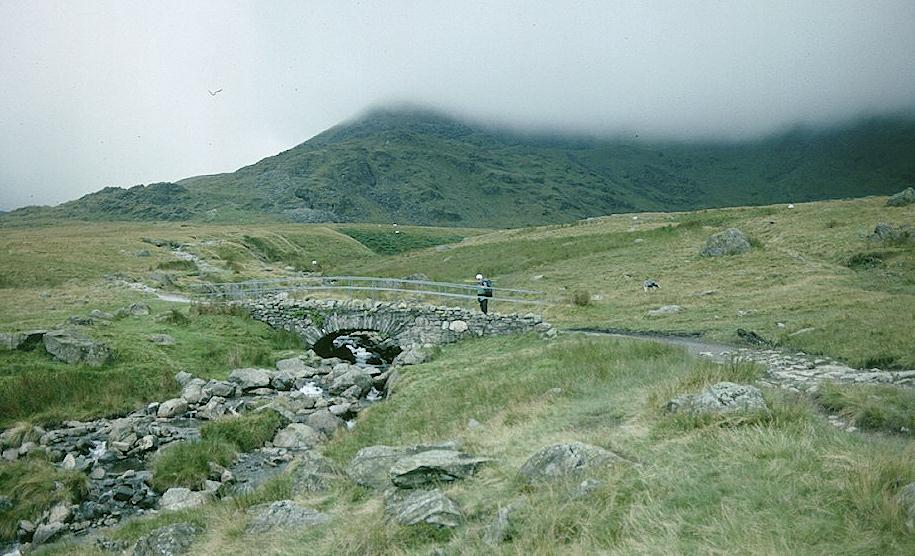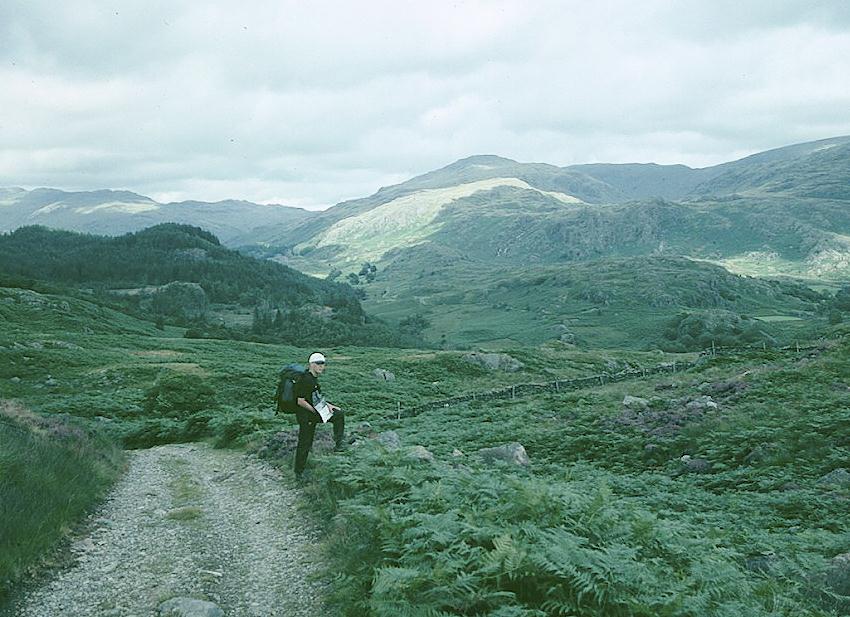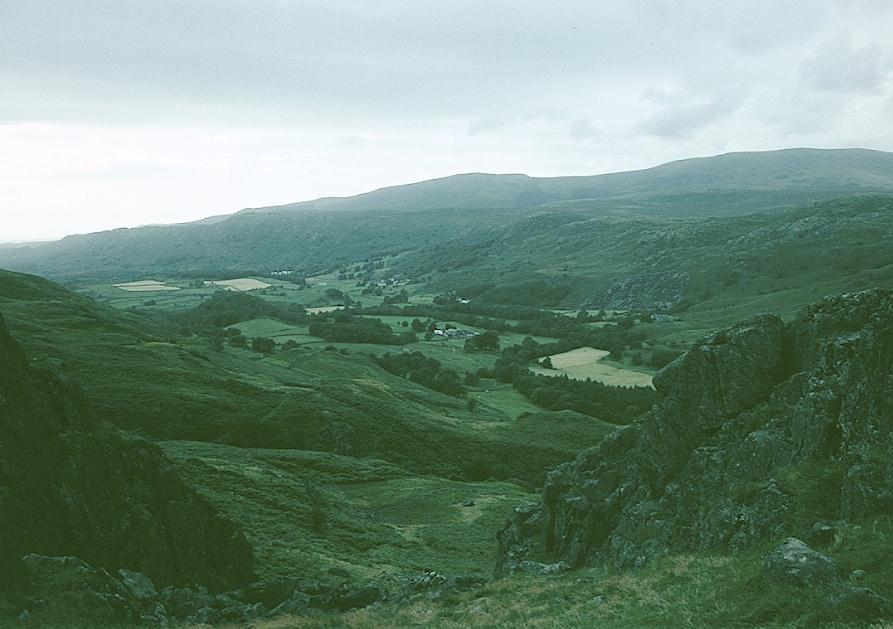August 19, 1994: Coniston to Boot
It was still raining when Gavan and I arose on the morning of Friday, August 19 – for our sixth day on the Furness Way. We darted about the empty streets, standing under awnings as we sought to buy extra liquid and snacks. In the breakfast room at 8:30 there was quite a crowd and only one overworked ancient waitress. Still, after I used my Access card to pay our bill, we were not too late in getting started on what proved to be another strenuous thirteen-mile day. It was 9:20 when we emerged from the Crown Hotel, already draped in our rain gear.
The steep ascent began almost immediately, as we climbed a village street to reach the same hotel, where, in 1985, Dorothy, Bertie and I were so rudely challenged by the owner during our check-in formalities that we left in protest. I held up a necklace of garlic and hissed as we inched our way past this establishment and continued our steep climb up more tarmac, heading in a southwesterly direction. There was a surprising amount of traffic on this lane because the Walna Scar route is the gateway to many of the Coniston fells and many young people were being ferried part of the way in vans and Land Rovers. There was a brief twist in the road and it then straightened out again to end in a parking area where tarmac gave way to a rough dirt track. A large group of walkers was marshalling here.
The Walna Scar Road is an old mining track that is suitable for vehicles only in part. At other times it is too steep, too rutted and too rocky even for a Land Rover. We now enjoyed a fairly level stretch as we pressed forward. Views of Lake Coniston were available behind us; to our right the Coniston fells were still shrouded in mist at the higher elevations, but we never saw the waters of Boo Tarn ahead of us – it seems to have been choked by reeds and other vegetation. The rain was almost at an end, though occasionally there would be mist and I would have to put my rain cape back on.
We had a chat with a scoutmaster. Like others we encountered on this busy route he expressed incredulity when we told him we were on our way to distant Boot. We crossed Cove Bridge, near the headwaters of Torver Beck, the same waters that we had crossed near the A5094 at the end of our first day of walking on the Cumbria Way in 1985. There were several steep sections as we neared Walna Scar Pass; at 1990 feet it was almost twice as high as Top O’Selside. The mist returned here, at 11:40, and a fierce wind blowing up from the Duddon valley made it very hard for me, even with Gavan’s assistance, to get my rain cape on. Indeed, as we began our descent I had to fight against becoming airborne for a number of minutes.
The prospect before us was exhilarating. The valley deep below us, with its green fields and farmsteads, was surrounded by a series of magnificent fellscapes, including one ridge which we knew we would have to conquer later in the afternoon. Gavan, who was making his first visit to the Lakes, was beginning to appreciate their grandeur; by the end of the trip he was able to describe this introduction to Cumbria as the greatest of all our walks in terms of scenery.
The route to the valley floor was straightforward; it involved quite a steep descent – still on the Walna Scar track – for some distance, with the direction then shifting to northwest before we entered the world of sheep and pasture again. There were a few families struggling up as we climbed down. In only an hour or so we were on tarmac, using a lane to rejoin the main valley road in lush surroundings. Before long we were in the village of Seathwaite, and shortly beyond its church we were greeted by the welcoming sight of the Newfield Inn. It was 12:55.
There were no other customers in evidence when we first arrived but others did follow us in after we had secured our pints and placed of food orders. I couldn’t figure out how such a remote hostelry, far off the main tourists routes, could survive, but we were certainly glad to have the inn on this day. I had my last order of scampi and chips and sipped at my lager. When an hour had rolled by I suggested we make a move – we still had six and half miles to go and it was just nearing 2:00.
Outside the sun had made an appearance and we would have sun and rolling clouds the rest of the day – all threat of rain lifted. A short distance from the pub a sign advised us of a new route down to a bridge over Tarn Beck – but we ignored this in favor of the direct route to some stepping stones described by Hannon – and then had to retrace our steps when this proved impractical. At the bottom of a wooded hill we used a bridge to cross the beck and when we saw the submerged stones after turning left we were glad we had done so. We then accompanied the beck until it was joined by Wordsworth’s Duddon itself, a clear wide stream whose stepping stones we were able to use a few minutes later. We then followed a woodland path to arrive at High Wallowbarrow Farm, a unique farmstead in red herringbone stone. A pig (well it resembled a wild bore as much as a pig) snuffled up to us in one of the pens and wagged its tail.
We turned right above the farm and followed a rocky track steeply uphill. There were sections as hard to master as Walna Scar Pass and both of us took a number of rests as we climbed up beside the heather-covered slopes of Wallowbarrow Crag. At the top we entered a truly magical atmosphere, a fairly level stony track leading through heather to the farm at Grassguards – while hills of every height, some tree covered, some bare fellside, loomed ahead. When we reached Grassguards we were reminded by Hannon not to cross the stream but to head up its left flank. This we did, the path fading in and out amid marshy surroundings as Harter Fell came into greater prominence on our right.
The next section was, frankly, a mess. The Forestry Commission, which had complex diversion signs on posts at a number of spots, had been at work on everything but drainage. There were new plantations on our left and ahead of us, while on our right trees had been felled with the delicacy of a blowtorch. Underfoot it was very marshy and we often had to pull a boot out of a pool of grassy muck. There we lots of little streams about and Gavan decided eventually that we had lost contact with our original beck and that we needed to move more to the right. This was correct and we were once again heading toward a break in the skyline on firmer ground. But felling seemed to have destroyed the original path and its substitute was hard to follow amid the wreckage of rotting tree stumps. We met another walker descending form what Hannon calls Harter Brow Pass; this chap described the scene as reminiscent of the Battle of the Somme – “No survivors.” It was also hard to tell when we had reached the summit of our efforts, for the saddle was rather broad, but eventually we were heading downhill into Eskdale. Some care had to be taken in seeking out the correct path down to the valley floor; this involved our climbing a stile and crossing the stream on our left to follow a green path through a marvelous pair of crags, gateway to the charms of Eskdale – beckoning in the late afternoon below.
Climbing down between these cliffs was quite precipitous and when we had reached the bottom we had to keep to a level track of uneven boulders accompanied on the right by a stone wall; it was not pleasant walking and I was glad when we at last met a tractor track that lead downhill onto the valley floor. For a brief time we were joined on our right by a path that carried the Roman Way; I was thus retracing a route I had undertaken with the Lees in 1987 as we marched through the farmyard of Penny Hill. The guidebook speaks of the farm’s friendly and enthusiastic collection of dogs, but we encountered only one; he seemed friendly enough. Then we followed the farm’s access road up to the Doctor Bridge, crossed this structure, and sat down on some rocks on the banks of the Esk for a rest, our first in three hours. Gavan wanted to know how much I would give him to jump off the bridge into the river. I said I would give him fifty quid but he decided not to bother. We had some liquid and a snack. I finally ate the cupcake that Mrs. Ellwood had given us at Everard Lodge.
In retrospect our old Roman Way into Boot should have been followed but Hannon had his own ideas on how to get us off the road. As we followed tarmac toward Boot he ordered us to turn right on a farm track to Christcliff Farm. Here we encountered the first of a series of public footpath signs that represented the triumph of hope over reality. We crossed a scruffy field and heaved ourselves over a rocky wall into a second field in which the carcass of a blue van blocked the route. Then we scrambled over another rock wall and began a series of twists and turns in narrow spaces choked with brambles and manure. The stiles encountered in this up and down progress were not sufficient to overcome another lopsided Gates victory 26-8. The views to our left, across Eskdale’s sheep-filled floor to the waterfalls flowing down the fellside, were some compensation for the fact that only three hundred yards from Boot we were still missing turnoffs in the complex game of route finding that eventually put us into the village’s main (indeed only) street at 6:00.
We were standing directly in front of the town’s post office/store, which also shared premises with John Gray’s Dale View b&b. Some Australians were just emerging from the spot and they summoned up our proprietor – who showed us to a nice room on the first floor. We each had a bath in a lovely big bathroom and then headed over to The Burnmoor Inn, where we had drinks and dinner. I had exhausted my intake of seafood and ended up with wienerschnitzel, a mistake. After dinner I returned to our room for the cigars and stood next to the pub’s flower garden for several minutes waiting for a girl to get off the phone. I had just given up and reentered the pub when Gavan signaled I was to go back; she had hung up at last and I could reach Dorothy. The Inn was really crowded and we didn’t feel like smoking our stogies here so we had a last stroll in the dark, walking as far as Brook House, where the Lees and I had stayed in 1987. It was chilly out and the last of the light had faded from the sky when we returned to our room at 9:30 for a well-deserved sleep.
To continue with the next stage our walk you need:



